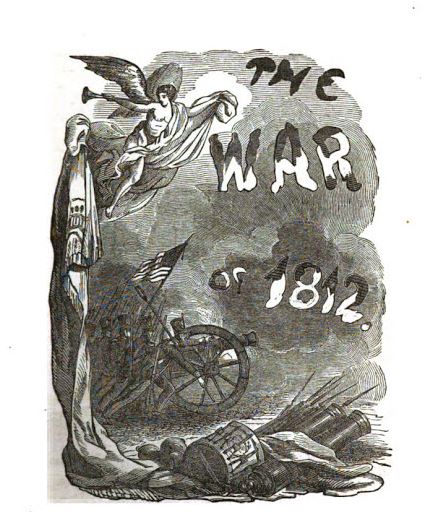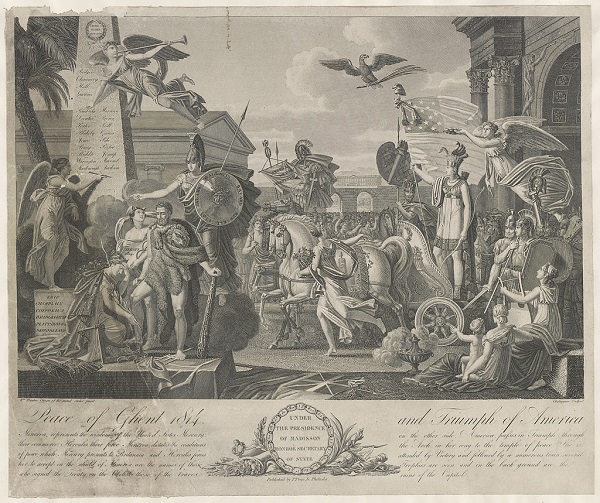The War of 1812 took place between 1812 and 1815. It was a conflict between Great Britain and the United States which was triggered by British interference in American trade.
The battles of the War of 1812 were fought on both land and sea. The land battles occurred in North America and the naval battles mostly occurred on the Atlantic ocean but a few also occurred on the Pacific.
The war officially came to an end when the Treaty of Ghent was signed in December of 1814 but news traveled slowly in those days so fighting continued into early 1815.

War of 1812 illustration, published in the Military Heroes of the War of 1812
The following is a timeline of the War of 1812:
1793:
♦ On February 1, 1799, France declares war on Great Britain in what comes to be known as the French Revolutionary Wars.
1803:
♦ Great Britain declares war on France in what comes to be known as the Napoleonic Wars.
♦ Great Britain begins to impress American sailors and force them to serve in the British Navy.
♦ Great Britain and France begin to block the United States from trading with the other to prevent supplies from getting into enemy hands.
1804:
♦ On December 2, 1804, Napoleon is crowned Emperor of France following a coup d’etat.
1806:
♦ In January of 1806, Secretary of State James Madison delivers a report discussing British interference in American trade and the impressment of American sailors, fueling anti-British sentiments.
♦ On April 18, 1806, the non-importation act is passed which placed restrictions on British imports.
♦ On November 21, 1806, Napoleon issues the Berlin Decree which forbade the import of British goods into European countries allied with or dependent on France.
1807:
♦ On June 22, 1807, the British ship Leopold fires upon the American ship the Chesapeake, which escalates tensions between the two countries.
♦ On November 11, 1807, Great Britain passes the 1807 Orders in Council, blocking international trade with France.
♦ On December 22, 1807, Thomas Jefferson imposes an embargo on Great Britain and France by closing all U.S. ports to export shipping and places restrictions on British imports.
1809:
♦ President James Madison ends the embargo due its devastating effects on the economy.
♦ On March 1, 1809, the non-intercourse act is signed into law. The act prohibits trade with Great Britain and its allies and with France and the countries controlled by France.
♦ On March 4, 1809, James Madison is inaugurated President of the United States.
1810:
♦ On May 14, 1810, Macon’s Bill Number 2 goes into effect. The bill states that if either Britain or France ceased attacking American merchant ships, the United States would end trade with the other, unless that other country agreed to recognize the rights of the neutral American ships as well.
1811:
♦ On November 7, 1811, the Battle of Tippecanoe takes place, which is considered the first battle of the War of 1812.
1812:
♦ In early June of 1812, President James Madison sent a message to Congress in which he listed complaints about British impressment of American sailors, harassment of American merchant ships by British warships and British blockades of American merchant ships bound for European ports.
♦ On June 4, 1812, the House of Representatives voted 79 to 49 in favor of war with Great Britain.
♦ On June 16, 1812, Great Britain suspends the Orders in Council.
♦ On June 17, 1812, the U.S. Senate voted 19 to 13 in favor of war with Great Britain.
♦ On June 18, 1812, the United States declared war on Great Britain.
♦ June-August of 1812, riots break out in Baltimore in protest of the war.
♦ On July 12, 1812, U.S. forces under General Hull enter Canada in the first of three failed attempts to invade Canada.
♦ On July 17, 1812, the Siege of Fort Mackinac takes place in Michigan.
♦ On August 5, 1812, the Battle of Brownstown takes place in Michigan.
♦ On August 16, 1812, American General William Hull surrenders Fort Detroit to the British without a fight.
♦ On August 19, 1812, the USS Constitution defeats the HMS Guerriere.
♦ On October 13, 1812, British General Isaac Brock is killed during the Battle of Queenston Heights in Canada.
♦ On October 13, 1812, Great Britain issues another Order in Council authorizing British military forces to conduct general reprisals against the military forces, merchant shipping and people of the United States. The order is considered a declaration of war.
♦ On November 28, 1812, skirmish at Fort Erie in Canada.
♦ On December 29, 1812, the USS Constitution defeats the HMS Java.
1813:
♦ On January 9, 1813, Great Britain issues a declaration defending its reasons for going to war.
♦ January 18-23, 1813, the Battle of Frenchtown takes place in present-day Michigan.
♦ On January 23, 1813, the River Raisin Massacre takes place in Michigan during which 30 to 60 captured American soldiers are executed by the natives
♦ On February 22, 1813, the Battle of Ogdensburg takes place in New York.
♦ On March 4, 1813, President James Madison is inaugurated for his second term as President.
♦ On April 27, 1813, the Battle of York takes place in present-day Toronto, Canada. The British are defeated and American troops occupy the city for six days, looting homes and setting fire to the shipyard, Government house and the Parliament buildings.
♦ April 28-May 9 of 1813, the Siege of Fort Meigs takes place in northwestern Ohio.
♦ On September 10, 1813, the Battle Lake Erie takes place on Lake Erie off the coast of Ohio.
♦ On October 5, 1813, the Battle of the Thames takes place in Ontario, Canada during which Shawnee Chief Tecumseh is killed.
♦ On November 11, 1813, the Battle of Crysler’s Farm takes place in Ontario, Canada.
1814:
♦ On April 4, 1814, Napoleon abdicates and is exiled to Elba off the coast of Tuscany, which ends the Napoleonic Wars in Europe. Great Britain now focuses all of its attention on the war in North America.
♦ On July 5, 1814, the Battle of Chippawa takes place in Ontario, Canada.
♦ On July 22, 1814, the Treaty of Greenville is signed which establishes peace between several native tribes (Wyandots, Delawares, Shawnoese, Senacas and the Miamies) and the United States. It also forms an alliance between these tribes and the Americans against the British in the War of 1812.
♦ On July 25, 1814, the Battle of Lundy’s Lane takes place at Niagra Falls in Ontario, Canada.
♦ In August, peace negotiations begin in Ghent, Beligum.
♦ On August 9, 1814, the Treaty of Fort Jackson is signed which establishes peace between the Creek nation and the United States in the Creek War.
♦ On August 24, 1814, the Battle of Bladensburg takes place in Maryland.
♦ On August 24-25, 1814, the British burn Washington D.C., including the White House and the U.S. Capitol building, in retaliation for the burning of York. President James Madison flees the capitol.
♦ On August 27, Fort Warburton, aka Fort Washington, is abandoned by American troops and destroyed to prevent its capture by the British.
♦ August 29-September 2, 1814, the Raid on Alexandria takes place in Virginia.
♦ On September 11, 1814, the British are defeated at the Battle of Plattsburg, aka Battle of Lake Champlain in New York.
♦ On September 12, 1814, the Battle of North Point takes place in Maryland.
♦ September 12-15, 1814, the Battle of Baltimore takes place in Maryland during which Fort McHenry is bombarded by the British.
♦ On September 14, Francis Scott Key writes the first lines of his famous poem, the Star-Spangled Banner after witnessing the bombardment of Fort McHenry.
♦ On November 6, 1814, the Battle of Malcolm’s Mills takes place in Ontario, Canada.
♦ November 7-9, 1814, the Battle of Pensacola takes place in Florida.
♦ December 14-January 5, the Hartford Convention meets in Hartford, Connecticut to discuss the delegate’s grievances with the War of 1812 and political problems concerning the federal government’s increasing power.
♦ On Christmas Eve in 1814, the Treaty of Ghent is signed which officially brings the War of 1812 to an end.
♦ On December 28, the Treaty of Ghent is ratified by the British.

“Peace of Ghent 1814 and triumph of America,” engraving by Alexis Chataigner, circa 1815
1815:
♦ On January 8-18, 1815, the British are defeated in the Battle of New Orleans in Louisiana.
♦ On February 16, 1815, the Treaty of Ghent is ratified and President Madison declares the war over.
♦ On February 17, 1815, Secretary of State James Monroe presents the signed treaty to the British minister in Washington D.C.
♦ On February 20 – USS Constitution engages the HMS Cyane and HMS Levant, not knowing the war was over.
♦ On April 6, seven American imprisoned sailors are killed and 32 wounded in the “Dartmoor Massacre” at Dartmoor Prison in Devon, England.
♦ On May 24, 1815, the Battle of Sink Hole takes place in Missouri.
To learn more about the War of 1812, check out the following article on the Best Books About the War of 1812.
Sources:
The Historical Register of the United States. Part 1: From the Declaration of War in 1812, to January 1, 1814. T.H. Palmer, 1814.
Encyclopedia of the War of 1812: A Political, Social and Military History. Edited by Spencer C. Tucker. ABC-CLIO, 2012.
“The Sacre or Consecration of Napoleon I.” Napoleon.org, Foundation Napoleon, www.napoleon.org/en/young-historians/napodoc/the-sacre-of-napoleon-i/
“War of 1812 Timeline.” Civil War Trust, www.civilwar.org/learn/articles/war-1812-timeline
“War of 1812: Timeline of Major Events.” PBS.org, Public Broadcasting Service, www.pbs.org/wned/war-of-1812/timeline/
“A Capitol in Ruins.” Senate.gov, United States Senate,
www.senate.gov/artandhistory/history/minute/A_Capitol_in_Ruins.htm
“The Senate Approves the Treaty of Ghent for Ratification.” Senate.gov, United States Senate,
www.senate.gov/artandhistory/history/minute/Senate_Approves_Treaty_of_Ghent.htm
